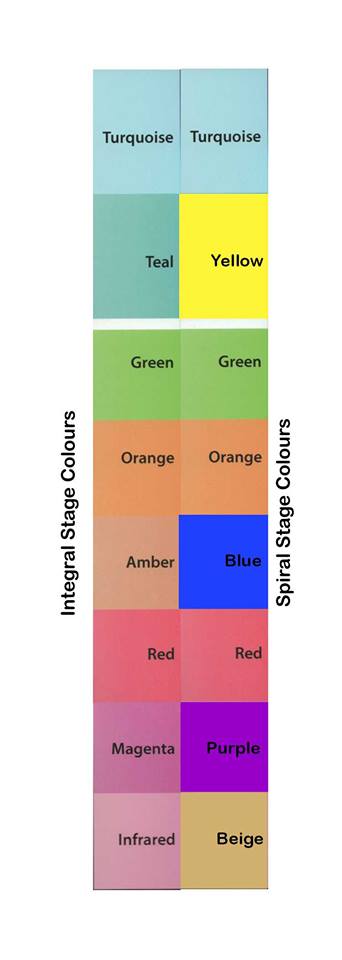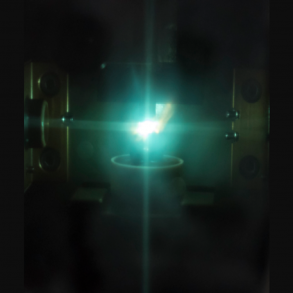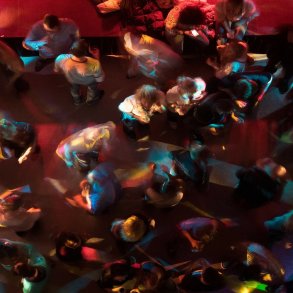Written originally by Jon Freeman for Integral Leadership Review – edited excerpts by George Pór
So what’s this “Teal” organisations thing?
There has been some major buzz generating about “Teal” organisations. It started with Frederic Laloux’s book Reinventing Organizations. There are some good videos on YouTube of Frederic talking about it, and if you haven’t read it, you can easily get an overview. The buzz has been amplified by other conversations. One of the example organisations, the Dutch healthcare company Buurtzorg, has particularly inspired people in Europe, and its founder/CEO Jos de Blok is also a regular speaker on the topic.
Frederic’s book is inspirational, filled with stories and well-pitched to appeal to people with integral mindsets, supported by a foreword from the great Wilber himself. The book uses Wilber’s general progression from Amber through Orange and Green as its framework for examining organisational change [see the left side of the colour scheme below]. It presents the emergence into Second Tier and Teal; as the book’s strapline says, it’s a guide to creating “organisations inspired by the next stage of human consciousness.”
Frederic identifies three core breakthrough practices that are characteristic of Teal organizations. He also describes some of the ways in which his exemplar organisations have dealt with some of the issues that may appear to be reasons why the old forms must be retained: Where do decisions happen? If you remove hierarchies, who is responsible? If you don’t have the conventional rules, what ensures that people do not abuse the system? If you don’t budget in the traditional ways, how do you manage finances?
What I wish to address here is the perception or assumption that Frederic has presented the whole Teal picture/worldview. I have reason to believe that this is causing people to have oversimplified perceptions of what introducing Teal will require.
That is not a criticism of Frederic’s book. He has a particular message, and an inspirational task that would be lost if the book had attempted to become an implementation manual. The book is what it needs to be.
Nor am I criticising Laloux himself. He is not an integral theorist. He is not steeped in Graves’ theory nor Spiral Dynamics. He is using the high-level picture of stages of human development, and taking the colours as a useful mnemonic for his readers to work with. It is a brilliant start, but it can be only that, and if we are to make good use of the opening he is creating, we had better understand what else is required.
Fortunately, there is a lot of the “what else” that is well understood. It is not yet widely known – certainly not as widely known as it will need to be – but it exists. Those who have interest in this arena of work, and anyone who wishes to support organizations with their journeys towards “Teal,” will gain from engaging with this knowledge. My purpose in this article is to create something of a map for that endeavour. I will return to what Frederic says, in order to reveal what hasn’t yet been said and what needs to be better known.
 One aspect of the enthusiasm for TEAL (YELLOW[i]) is the delight felt by GREEN[ii] in the lessening of BLUE/AMBER structural hierarchy, as well as the accompanying shifts in ownership models and reward models that may lessen ORANGE influences.
One aspect of the enthusiasm for TEAL (YELLOW[i]) is the delight felt by GREEN[ii] in the lessening of BLUE/AMBER structural hierarchy, as well as the accompanying shifts in ownership models and reward models that may lessen ORANGE influences.
Some people with GREEN mindset have believed that TEAL eliminates hierarchy, rather than recognising the more complex and subtle shift in hierarchy that Laloux is describing.
TEAL does not always change the structure, but rather alters the way in which the structure is being operated.
I would like to take this one step further. Those who do not understand the integration of stages required in TEAL/YELLOW and don’t understand the fact that include is at least as important as transcend, may view TEAL as something separate from all previous stages – as if the world has made a quantum jump to a new state.
This does not represent Laloux’s model and it does not represent anything else about the shift the world is making, when viewed within the Graves/SD framework.
Operating from those lacks of understanding is an error which makes it much more difficult to understand the challenges an organisation faces in its journey to Teal, and also impairs our ability to work within such an organisation or support it in its change process.
People in a Teal organisation do not themselves “become” Teal.
In correspondence, Frederic has supported this point of view:
“So my (simplified for the sake of brevity) view on how people viewing the world primarily from stages below TEAL can work with pleasure in a self-management setting is if it is presented this way:
- for Amber: here is the new set of rules and structures – clear and consistent.
- for Orange: it’s a new game, and here are the new rules. Have fun trying to be the best at the game.
- for Green: it’s a new game, where everyone can contribute, where no one’s voice can be denied.
I clearly see how articulating something like this would be powerful.”
Clare Graves is often quoted for his strong expression “Damn it all, people have a right to be who they are.” Many people have made a related mistake in their view that individuals on a developmental journey somehow become Teal/Yellow and that their First Tier existence then vanishes.
That perspective is being projected onto organisations, in the expectation that not only will a Teal organisation somehow lose all of its First Tier values systems, but somehow all the people in the organisation will also become Teal individuals. This is not how it works. Not only do people have the right to be who they are, they will be who they are, until and unless they choose to change. Many will change very slowly, and many not at all.
In Reinventing Organizations, we see in the examples, many of the outcomes possible when solutions are found to the First Tier problems of existence. Each organisation has done this in its own way, using advice process, Holacracy® and many other techniques to deliver Laloux’s three breakthroughs of Teal organizational functioning: Evolutionary purpose, Self-Management and Wholeness.
No two organisations are the same. Each started from a different position – some with established history, and some, like Buurtzorg, from scratch. Each has its own mix of people and its own business conditions.
What do we need to know?
Is it obvious that the methods used by Buurtzorg could not be transposed to AES or FAVI? I suggest that it should be, and that this points to the questions we would need to ask and the aspects that we would need to know if undertaking the journey elsewhere. Inspiring as the book’s examples are, they are numerically a drop in the ocean, and while we can see where they have gotten, we have little knowledge of how they got there.
Each organisation which sets out on the path towards Teal/Yellow/Flex-flow/conscious/Integral/meshwork organisational existence will be unique. Each will start from where they are; each will set its own priorities – what changes to make first. Each will choose what tools and techniques to adopt, and in what order, and each will have a unique experiential journey leading, hopefully, to its individual expression of fulfilling its purpose.
The history of company change is in many cases one of finding a technique like Deming or Six Sigma and applying its methods. Here, there is no bolt-on structure. For example, Holacracy might or might not be useful.
Teal is co-arising with a raft of approaches – Presencing and U-lab, for example – and a range of authors opening up the pathway – Meg Wheatley, Peter Senge, Dee Hock, among many. These are supported by many views of leadership: inspirational, evolutionary, conscious, resonant, and more.
There are valuable insights into how we think in terms of emotional intelligence, spiritual intelligence, and polarity management – and more insights arriving all the time. The underlying, less visible forces – the “invisible dynamics”[iii] – are being revealed in systemic constellations and Deep Democracy. Day after day I find myself meeting with practitioners who have developed their skills in multiple approaches of these kinds.
How do all of these exciting and potent possibilities relate to Spiral Dynamics and Integral? Does knowledge of SDi contribute anything to this buffet? Does it support the evolutionary journey and offer any assistance in developing more “organizations inspired by the next stage in human consciousness?” For the remainder of this article I am intending to describe how and why I believe that it does.
What can we do?
The GREEN stage of development is magnificent. It led us into the exploration of who we are, individually and collectively. It birthed psychology, anthropology, and sociology. It began the dissolution of some paralysing BLUE/AMBER structures and countered the excessively materialistic (both financial and scientific) emphasis of the ORANGE mindset. It taught us about diversity, inclusion, and consensus.
It cares about the environment, and challenges materialist blind spots. GREEN is co-operative, team-oriented, and accepting; it reawakens the human bonding that has been reduced in varying ways by all of the stages since PURPLE. During the ORANGE stage, alienation and loneliness become key human themes; twentieth-century novels are filled with these themes. GREEN redresses this imbalance. It’s the Gravesian pendulum between “I and We” in full swing back from “I” to “We.”
TEAL/YELLOW is the next stage in human consciousness after GREEN. It arises out of both the strengths and weaknesses of GREEN. GREEN loses sight of the ORANGE potency that built a world that can support more people in higher material standards, and in greater connectivity and mutual awareness, than ever before. GREEN, as discussed, dislikes hierarchy and its emphasis on consensus can make it unable to embrace any structure. It can also be confused about what consensus is, thinking that “our way” is “everybody’s way.”
While tolerant of race and gender differences, GREEN can be intolerant of diversity of opinion both within a group and beyond. In all of these challenges, GREEN might put emotions and feelings first. It might be so concerned to love the sinner that it fails to deal with the sin. It might put people so far above organisation in priority, focus, and concern, that the organisation itself loses viability. The pendulum can swing too far.
If we are not careful, TEAL/YELLOW can look, in presentation, like an advanced form of GREEN. It is essential that we grasp the distinctive quality of TEAL/YELLOW. TEAL/YELLOW is functional and pragmatic. It does not cease to care about feelings, but it will not lose sight of the needs of the whole by denigrating other aspects of existence.
The essential aspect of TEAL/YELLOW: it is systemic, and demands the structural awareness that we previously developed during the BLUE/AMBER stage.
It demands the material underpinning that was the strength of the ORANGE stage. It sees the need for individuality to be expanded as part of our collective expansion, not suppressed in a search for equality. It understands how to embrace the equality of human value without making anybody less than they can be.
All of this is present in the RO example-organisations, and it is valuable for us to understand how it shows up. TEAL does not eliminate AMBER. The challenge as we enter Second Tier is to replace the old BLUE/AMBER with something which fulfils that stage’s original function of placing order and boundaries around the chaos of RED, but which also has the built-in intelligence and articulation to support the ORANGE and GREEN that have emerged since the predominance of BLUE/AMBER in humanity.
Structure and process have to be smarter now. Similarly, we have to replace any dysfunctional aspects of ORANGE which are incompatible with GREEN, or which would seek to out-manoeuvre the newer and more subtle form of BLUE/AMBER. We need a smarter ORANGE that is not blind to human or material inter-dependencies.
And not to forget that we still need the Values of bonding and heroic individual empowerment that were present in PURPLE/MAGENTA and RED (respectively) to be positively present. Even the survival stage BEIGE/INFRARED should not be taken for granted. All six First Tier levels are needed.
The Tier-Two integration into TEAL/YELLOW functioning/operating is assisted when we are able to recognise how these dynamics are represented in both people and organisations. In practice, it is unlikely that an organisation will even think about the journey to TEAL unless it already has a significant portion of GREEN in its thinking systems.
However, those higher systems may be more strongly present in the decision-makers than in the organisation as a whole. The widely publicised example of Zappos, which paid employees to leave, might have been the right solution, but you might at least question whether greater anticipation of the difficulty could have opened the door to a less drastic response.
I am suggesting that the ability to scan the organisation in order to determine the Values profile of the whole, and of component teams and groups, could be very helpful. It is also possible to scan the organisation for its readiness individually and collectively for change.
There are many principles which come into play when we know what we are starting with. If the conditions conducive to change are not yet established, we might begin to address those conditions before starting the change itself. Knowing, as we do, that a system is typically only capable of moving half a stage (e.g. ORANGE to ORANGE/GREEN) from its current centre of stage-gravity enables us to pitch the next step in change at an appropriate level.
Knowing the colour make-up of a team helps us to see who would embody the qualities of the next stage in such a way to be the most capable change leader.
Knowing the Values we are presenting messages to, about possible changes, helps us craft those messages that are most effective for the audiences concerned.
These suggestions skim the surface of what is possible when we use the deeper intelligence that sits within the evolutionary journey that Laloux’s book describes. Teal is naturally emerging, but it needs such support for the organisational journey if it is to succeed, and to sustain in its new form.
[i] I use both Spiral Dynamics and Integral colour schemes in this article. A diagram showing the two together, and an explanation of how they came to be different, can be found in the original ILR article.
[ii] Descriptions of colours in this mode are intended to depict individuals and groups who have this way of thinking as their core Values system centre of gravity. They are not types of people.
[iii] Invisible Dynamics: Systemic Constellations in Organizations and in Business. Klaus P. Horn and Regine Brick
 Jon Freeman is a strategic thinker and consultant specializing in systemic organizational redesign in support of conscious, values-led and purpose-driven culture change. He is also a Spiral Dynamics trainer and practitioner, and author of Reinventing Capitalism: How we broke money and how we fix it, from inside and out.
Jon Freeman is a strategic thinker and consultant specializing in systemic organizational redesign in support of conscious, values-led and purpose-driven culture change. He is also a Spiral Dynamics trainer and practitioner, and author of Reinventing Capitalism: How we broke money and how we fix it, from inside and out.





Thanks George, for bringing Jon’s work to the fore. Much to be learned as we individuate AND integrate. Onward…..
Thanks George,
for letting us see Jon Freeman’s article. Thank you Jon for the depth in which you describe the challenges of “going Teal”. With all the transcending not to loose the including is really crucial.
Frederic Laloux’ book opens the door to what is possible, successfully possible, not the journey itself. This is one of the reasons he initiated to write the “Reinventing Organizations Wiki” to have a place where the book can outgrow itself with more and more examples, procedures, practices to learn from.
I know a CEO who had that longing to find new ways (after Green) but did not have any idea how. He was so inspired by the examples in the book that he initiated a conversation with his managers and the whole staff where they all, 115 people, decided to go the step to Self-Management. Wholeness and Purpose were already there. And 4 months later they had better figures as before the leap.
Thanks again, I read the article word by word. Really great
Gertraud
Gertraud, would you interview him for EE, or put us in touch whim?